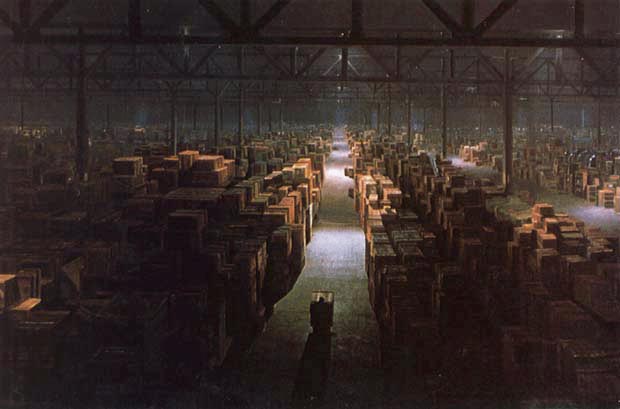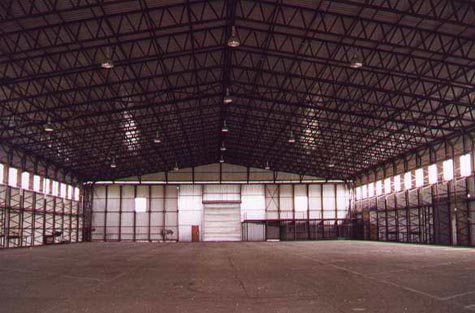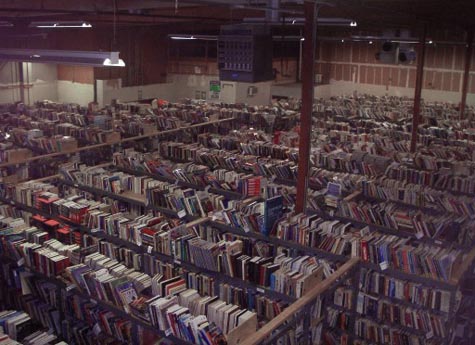The future warehouse of unwanted books
 [Image: The unforgettable final glimpse of a U.S. government warehouse from Raiders of the Lost Ark].
[Image: The unforgettable final glimpse of a U.S. government warehouse from Raiders of the Lost Ark].A warehouse is being constructed to house books no one's reading.
"The warehouse is extraordinary," the Guardian writes, "because, unlike all those monstrous Tesco and Amazon depositories that litter the fringes of the motorways of the Midlands, it is being meticulously constructed to house things that no one wants." Those "fringes" are outside London.
"When it is complete next year, this warehouse will be state-of-the-art, containing 262 linear kilometres of high-density, fully automated storage in a low-oxygen environment. It will house books, journals and magazines that many of us have forgotten about or have never heard of in the first place."
The building's temperature will be regulated. It will be sealed against moisture. It will hold copies of books that no one actually cares about.
Indeed, this is where unwanted books "will go to serve their life sentences in a secure environment," the Guardian explains, "thanks to the grace of the provisions of the 1911 Copyright Act [UK] and later government legislation."
In other words, a relatively random piece of 100-year old legislation – dealing with copyright law, of all things – has begun to exhibit architectural effects.
These architectural effects include the production of huge warehouses in the damp commuter belts of outer London. These aren't libraries, of course; they're stockpiles. Text bunkers.
 From the Guardian:
From the Guardian:- "We need this warehouse," says Steve Morris, the British Library's head of finance, "not just because it is cheaper than existing rented warehouses we use in London, but also because we are statutorily obliged to house more and more material."
In other words, should we be saving books, CDs, PDFs, MP3s...?
And do we know that anyone will ever use them?
I'm tempted to say that we need an injection of Buddhism – or, at least, the doctrine of non-attachment – into the field of library science. But I'm not a Buddhist, so I'm not going to say that. (Interesting, though, that religious beliefs could affect both the shape and the very existence of libraries).
In any case, last month Anthony Grafton took a long look at the future of the library, gazing upon the history of textual accumulation from the Library at Alexandria to Google's new book-scanning project.
 From The New Yorker:
From The New Yorker:- When ships docked in Alexandria, any scrolls found on them were confiscated and taken to the library. The staff made copies for the owners and stored the originals in heaps, until they could be catalogued. At the collection’s height, it contained more than half a million scrolls, a welter of information that forced librarians to develop new organizational methods. For the first time, works were shelved alphabetically.
Enter the printing press:
- The rise of printing in fifteenth-century Europe transformed the work of librarians and readers. Into a world already literate and curious, the printers brought, within half a century, some twenty-eight thousand titles, and millions of individual books – many times more than the libraries of the West had previously held. Reports of new worlds, new theologies, and new ideas about the universe travelled faster and more cheaply than ever before.
Or so we're told.

 [Image: The British Museum Reading Room: top photo via Wikimedia (view huge), bottom photo by Vlad Jesul].
[Image: The British Museum Reading Room: top photo via Wikimedia (view huge), bottom photo by Vlad Jesul].Fast-forward, then, to the present and you'll find even more gigantic air conditioned warehouses under almost continual construction on the sides of Western motorways – and you get some sense of how the quest for unrestricted information retrieval has taken on architectural form.
No matter if no one actually visits these places; they're our era's equivalent of pharaonic tombs. They're time capsules.
Quoting once again from the article by Grafton: "Though the distant past will be more available, in a technical sense, than ever before, once it is captured and preserved as a vast, disjointed mosaic it may recede ever more rapidly from our collective attention."
Perhaps it will take some future moment of cultural archaeology to break into these places, spelunking back into the literate past, to find well-tempered rooms still humming at 50ºF, humidity-free, where the past is refrigerated and Shakespeare's name can still be recognized on the spines of books.
Until then, these warehouses – again, not libraries – will continue to take shape as abstract windowless volumes outside cities on the freeway.
 Finally, I'm reminded of a few lines from The Name of the Rose by Umberto Eco, in which the book's narrator and his well-read "master," William of Baskerville, break into a labyrinthine library after dark – a library full of mirrors, unmarked halls, and trick doorways. (While lost in the library, the narrator beautifully remarks: "I proceeded as if in the grip of a fever, nor did I know where I wanted to go.")
Finally, I'm reminded of a few lines from The Name of the Rose by Umberto Eco, in which the book's narrator and his well-read "master," William of Baskerville, break into a labyrinthine library after dark – a library full of mirrors, unmarked halls, and trick doorways. (While lost in the library, the narrator beautifully remarks: "I proceeded as if in the grip of a fever, nor did I know where I wanted to go.")The architects of the library were, in fact, quite clever, mixing climate control with acoustic design:
- "The library must, of course, have a ventilation system," William said. "Otherwise the atmosphere would be stifling, especially in the summer. Moreover, those slits provide the right amount of humidity, so the parchments will not dry out. But the cleverness of the architects did not stop there. Placing the slits at certain angles, they made sure that on windy nights the gusts penetrating from these openings would encounter other gusts, and swirl inside the sequence of rooms, producing the sounds we have heard. Which, along with the mirrors and the herbs, increase the fear of the foolhardy who come in here, as we have, without knowing the place well. And we ourselves for a moment thought ghosts were breathing on our faces."
After all, the narrator then says, "I felt inclined to disobedience and decided to return to the library alone. I myself didn't know what I was looking for. I wanted to explore an unknown place on my own; I was fascinated by the idea of being able to orient myself there without my master's help."
And so he goes, lamp in hand, heading into that unlit space full of books no one's reading, in a surround-sound of breezes, looking for something he knows he'll never find.





Comments are moderated.
If it's not spam, it will appear here shortly!
as ever Geoff, this is fascinating. Thank you
I had the pleasure of working on the design for a storage library for Stanford a few years back. Three things that I still remember from that experience:
1. Books are placed in quarantine before being allowed into the storage area. Dust mites and other pests love book bindings and you have to make sure your incoming books won't infect the neighbors.
2. If there is a fire, they douse the books in water, and then freeze-dry them back to keep the paper from getting ruined.
3. Books in storage libraries are cataloged in the order that they are received-- the first book in the door is book #1, and so on. Without a very detailed and cross-indexed database, the books would be impossible to find (just like the ark?)
In Carlos Ruiz Zafo's novel The Shadow of the Wind, he describes The Cemetery of Forgotten Books: "...When a book is consigned to oblivion, those of us who know this place make sure that it gets here. In this place books no longer remembered by anyone, books that are lost in time, live forever."
That kind of sounds like these warehouses - a morgue for books that no one reads anymore, where forgotten literature slowly molds in climate controlled tombs.
I too was minded of Zafon's "The Shadow of the Wind" and its cemetery of forgotten books.
I am glad to know that my stories will find a nice place of rest.
Where was that last picture taken?
Harvard too has a library depository; a vast warehouse in the woods outside Boston, its shelves are forty-two feet high. When I visited it a few years ago, I was struck by what a ruin it will make--a vast glittering mine of books.
autoautistic, that's pretty fascinating stuff.
And the last image in the post is the library at Trinity College, Dublin.
libraries seem to constrict and free all at once -
“This liberation derives from a proliferation of meaning, from a self-multiplication of significance, weaving relationships so numerous, so intertwined, so rich, that they can longer be deciphered except in the esoterism of knowledge. Things themselves become so burdened with attributes, signs, allusions that they finally lose their own form. Meaning is no longer read in an immediate perception, the figure no longer speaks for itself: Between the knowledge which animates it and the form into which it is transposed, a gap widens. It is free for the dream.”
(Foucault, pp 18 - 19, Madness and Civilisation)
a wonderful article, many thanks.
"A library has traditionally displayed a different level of architectural rhetoric than, say, a warehouse. This is not a question of function, since both buildings are, in a sense, places for storage. But a library is supposed to look like a library - that is, it should reflect society's attitude towards books, learning, and knowledge."
-Witold Rybczynski, The Most Beautiful House in the World
Maybe we've become so overwhelmed by the amount of knowledge - and by its dubious quality - that all we can do is to warehouse the physical stuff and concentrate on search-able content.
Thanks for this post and for the wonderful photos. I'm a research library administrator at a major university in the USA. It would be great if library buildings could grow forever, right in the middle of campus, encompassing beautiful space for readers and prime environmental conditions for ever-expanding collections in all formats, new and old. This is not going to happen. Choices have to be made, and high density storage is very viable and cost-effective solution for items that are low use but still high value. (Research libraries are all about the "long tail").
This is from the prospectus for a facility modeled after the Harvard Depository mentioned above:
"... Faced with the need to house library materials and offer a wide variety of new services in already overcrowded campus buildings, academic libraries have few options. They can campaign for costly new buildings and scarce space on college campuses. They can attempt to artificially limit collection size, thereby negatively impacting research, teaching and learning. Or they can manage collections by sharing them through [consortial] partnerships, housing selected collections in less expensive space, and saving precious campus buildings for other uses."
What are those "other uses?" On many campuses, classrooms, labs, group study rooms, tutoring spaces, media production facilities, etc. are being collocated in and around libraries in a "Learning
Commons" program (see for example http://www.umass.edu/learningcommons/).
or http://library.uoregon.edu/commons/
These facilities are still libraries. They still contain millions of books, *plus* the tools and expertise for active learning and creation of knowledge.
I hope this is a helpful perspective; thanks again.
I think we're bumping up against that eternal problem of trying to anticipate what will be of interest/use/value to future generations.
In my field (social and design history with an emphasis on 'ordinary' rather than elite lives) surviving literature and ephemera relating to this are precious fragments of evidence that have endured by accident or luck because institutional/academic collecting policies were traditionally governed by notions of quality and craft, the natural territory of the connoisseur. The interests and preferences of the elite were prioritised up until very recently.
There are a number of value judgments in this piece (some quoted, I'll allow!) such as 'things that no one wants,' and, referring to the role of archives as 'keeping civilization going, with all of its awareness of the past' there is the pointed: 'or so we're told.'
The popular literature and magazines that, as far as I can gather, will make up most of the stocks in the British Library repository you mention first, might well prove to be valuable to future studies, much as earlier examples of the same kind now fuel my current work.
The battles over 'low' and 'high' culture and their relative values and importance have been fought and won. Haven't they?
Here's an example: how many people actually read the Booker prize winning novel of any given year? And how does that compare to the readership figures of, say, a celebrity gossip magazine, or a car buying guide? No matter what we might prefer to believe, which of these might be more revealing of the lives and preoccupations and values of the majority, and therefore useful fuel for historians like me?
I understand the mindbending logistical problems of storage - or at least, your article gives me an intimation of it - but I'm just speaking up for the stuff that 'nobody wants'. Right now, at least.
It is quite fascinating that you bring up the notion of religious and cultural beliefs influencing the way that we consider our attachement (or non-attachment) to knowledge. I can't help but think of a study I did of the Ise Shrine (a Shinto shrine in Japan, and one of the holiest Shinto places, on top of that), and the fact that it is a temple made out of wood and thatched grass that has been torn down and rebuilt every twenty years (for hundreds of years) so that it never appears OLD, and thus loses the perfectness of its form. It serves a great contrast to the Western affinity for "authenticity," or originality.
There was also a great dilemma raised when Western preservationists were brought into Nepal to help restore paintings in Buddhist shrines. They wanted, of course, to maintain the parts of the painting in fragments that were original, and repaint the replacement pieces in a slightly 'off' color, so that one could discern the difference between the original and the new. The Buddhists wanted the entire painting to be re-done in the style and manner of the original so that it became, again, a beautiful thing to contemplate.
In a Western world, it is only a matter of time before everything, including libraries, becomes a museum.
fascinating post and incredibly illustrative photos.
OK, now read this, especially the line "Finding the pre-1999 newsletters was no easy task, but I was able to track many of them down at the libraries of the University of Kansas and the Wisconsin Historical Society." No doubt they would have fit the BL's "nil use" criterion as stated in the Guardian article (no one looked at them in the past year), but if that were grounds for discarding them we'd have a very thin cultural heritage.
The British Library provides same-day delivery of items from its London warehouses to the reading room, and you can order these items online through the catalogue. The idea that these books won't be seen again until the archaeologists break through the ceiling is no more than a quaint conceit.
Hi Geoff, I find the concept of the archive quite fascinating, and see a lot of potential for experimentation. Personally the idea of a vast hoard of books hidden away immediately sparks my curiosity, and your reference to Umberto Eco sums up my excitement of the possibility of searching for something I may never find, let alone know what it is I’m seeking.
I found your quotes on Grafton particularly interesting, especially the idea that the archive as a record of the past provides an awareness that allows civilization to progress, yet the process of archiving itself often means that what has been learnt and stored begins to fade without opportunity for rediscovery.
Tom summed up the issues of the overwhelming access to information brilliantly. I believe an interesting alternative to the archive would be to play upon these notions of hidden inaccessibility, by implementing the use of an automated retrieval system as a method of creating a public spectacle that encourages users to engage with the concealed archives. In many examples that use these automated systems the user is only exposed to the input interface of the computer and the output of the book collection, whereas all the most interesting elements of the retrieval process are concealed.
Post a Comment